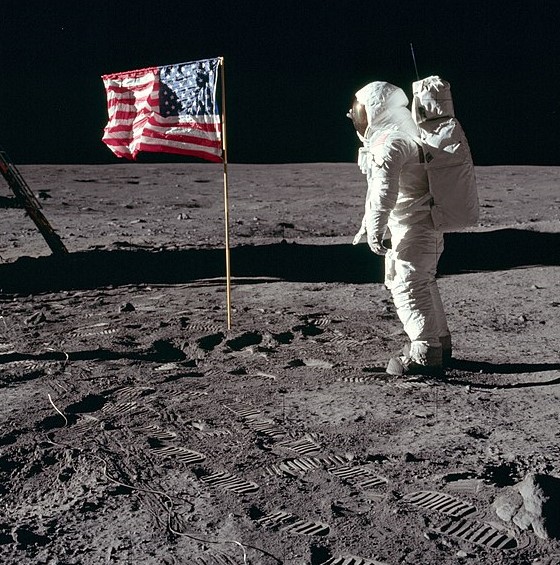Apollo 11 Mission 50th Anniversary Celebration Movie Night

Please join the School of Earth and Space Exploration for an exclusive Apollo 11 mission 50th anniversary celebration!
Featuring a pre-film reception, screening of the 2019 film "Apollo 11," and audience Q&A with Mark Robinson, principal investigator of NASA’s Lunar Reconnaissance Orbiter Camera, and members of the NASA LunaH-Map mission team.
Schedule of Events
5:30 p.m. Reception and meet and greet with ASU’s Lunar Reconnaissance Orbiter Camera and the LunaH-Map mission teams
6:30 p.m. Welcome remarks from Mark Robinson, principal investigator of the Lunar Reconnaissance Orbiter Camera
6:35 p.m. Screening of "Apollo 11"
8 p.m. Audience Q&A with moon exploration experts from the NASA Lunar Reconnaissance Orbiter Camera and the NASA LunaH-Map mission teams
About the Film:
"Apollo 11," released this year, focuses on the 1969 Apollo 11 mission, the first spaceflight to land humans on the moon. It is produced and directed by Todd Douglas Miller. In the making of this documentary film, Miller worked with NASA and the National Archives to incorporate unreleased 70 mm footage from the launch and recovery of Apollo 11. The film includes footage of the Launch Complex 39, spectators present for the launch, the launch of the Saturn V rocket, the recovery of astronauts Buzz Aldrin, Neil Armstrong, and Michael Collins and the Apollo 11 command module, and post-mission efforts aboard the USS Hornet. Watch the Trailer Here
About the Lunar Reconnaissance Orbiter Camera and its principal investigator, Mark Robinson:
The Lunar Reconnaissance Orbiter Camera, or LROC, is a system of three cameras mounted on the Lunar Reconnaissance Orbiter (LRO), a NASA spacecraft that launched in June 2009. The cameras capture high resolution black and white images and moderate resolution multi-spectral images of the surface of the moon. LROC's task is to help identify future human landing sites on the Moon, study the light conditions at polar-craters, and answer other lunar geology questions. The principal investigator of LROC is Mark Robinson of ASU’s School of Earth and Space Exploration. He is also the principal investigator for a new NASA lunar imaging experiment, ShadowCam, which is now under development.
About LunaH-Map and its principal investigator, Craig Hardgrove:
LunaH-Map (Lunar Polar Hydrogen Mapper) is a new type of NASA planetary science mission. LunaH-Map is a miniaturized, fully functional interplanetary spacecraft the size of a shoebox that will map hydrogen enrichments within permanently shadowed regions of the lunar south pole. The spacecraft will use a miniaturized propulsion system, attitude control, power and communications systems to maneuver into orbit around the moon. LunaH-Map will enter a low altitude, elliptical polar orbit and will measure the abundance of hydrogen using a new type of compact neutron spectrometer. Neutron measurements made at low altitude over the lunar south pole will allow LunaH-Map to constrain the hydrogen within permanently shadowed regions at unprecedented spatial resolution. The principal investigator of LunaH-Map is Craig Hardgrove of ASU’s School of Earth and Space Exploration. He is a planetary scientist with research interests in neutron and thermal infrared remote sensing of planetary surfaces (Moon, Mars, asteroids) to determine their volatile histories and evolution.
Light refreshments will be provided during the reception.
Parking
The Marston Exploration Theater is located on the first floor of ASU's Interdisciplinary Science and Technology Building IV (ISTB 4), the home of the School of Earth and Space Exploration. ISTB 4 (map) is located near the intersection of Rural and Terrace Road in Tempe on the east side of campus. This seven-story structure is ASU’s largest research facility, and is accessible on foot via Orange Street and McCallister Ave. If arriving by Light Rail, exit at the University and Rural Road stop.
Parking is available for $3/hour inside the Rural Road parking structure just east of ISTB 4. From the parking structure, walk west and enter ISTB 4 through the glass doors on the north side of the building. Please note that a parking fee is charged upon exit. There is additional pay parking directly south of ISTB 4 available for $2/hour. There is an automated payment registration kiosk on the parking lot's west side (the corner near the building).

